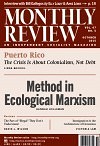Volume 67, Number 5 (October)

Fifty years ago this month, beginning in early October 1965 and extending for months afterwards, the United States helped engineer a violent end to the Communist Party of Indonesia (PKI). Between 500,000 and a million Indonesians were killed by conservative factions of the military led by General Suharto and by right-wing Muslim youth—all with the direct involvement of the CIA, the close cooperation of the U.S. Embassy and State Department, and the guidance of the Johnson administration’s National Security Council.… In forthcoming issues of Monthly Review we are planning to publish work on the Indonesian genocide, which, alongside the Vietnam War, constitutes a major turning point in the history of Southeast Asia in the period, and one of the most brutal acts of mass carnage inflicted by imperialism in the twentieth century. The dire implications of this carry down to the present day. | more…
Science and the Struggle for Change
In the short time available to me in this talk it is impossible to go too far with a discussion of the state of ecological Marxism as I understand it. However, I plan to discuss briefly a significant feature of the program of ecological Marxist analysis and practice of which I consider myself a part. Specifically, I will discuss the methodological commitments responsible for much of the strength and insight of the ecological Marxism associated with what John Bellamy Foster has called the “third stage of ecosocialism research…in which the goal is to employ the ecological foundations of classical Marxian thought to confront present-day capitalism and the planetary ecological crisis that it has engendered—together with the ruling forms of ideology that block the development of a genuine alternative.” This, I believe, will interest scholars and activists working toward a deeper understanding of the world with the ultimate goal of changing it, and should interest those involved in debates regarding Marxian theory and praxis. | more…
Tourists are fascinated by the heavy blue cobblestones that pave the streets of Old San Juan. Why they are there is as good an explanation as any for Puerto Rico’s current crisis. In the days of Spanish colonialism, they were ballast to keep the ships crossing the Atlantic from tossing about and blowing over. The ships came empty, and left for Spain full of gold, silver, and other riches stolen from the indigenous Taínos. The ballast left behind was used to pave the streets.… Puerto Rico has been sacked by colonial powers for half a millennium. Is it any wonder it is in dire straits? Today, it is $73 billion in debt. | more…
As we veteran activists of the 1960s and early ’70s enter our años del retiro, it is time for reflection, summation, and most importantly sharing what we have learned with those reaching to grab the baton. Many of us, now grandparents, are getting questions from our grandkids and kids about our lives in the “golden age” of U.S. social movements. … Bill Gallegos has been an activist since the 1960s, when he became involved in Crusade for Justice, a revolutionary Chicano nationalist organization. He has since emerged as a leading socialist environmental justice activist, and is the former executive director of Communities for a Better Environment. | more…
The Struggle for Public Water in Italy
Against the background of global and Eurozone financial crises, as well as the austerity sweeping across Europe, the pressure for governments to privatize public services is immense. Efforts to combat this are ever more necessary. This article examines one such effort, the Italian Water Movements Forum (also called just “the Forum”), a broad alliance of trade unions, social movements, development NGOs and environmental groups, and its successful 2011 mobilization supporting a referendum against water privatization. The article seeks to answer two questions. First, how was the Forum able to bring together such a wide range of different groups into a successful campaign? Second, why, despite the overwhelming success in the referendum, was there only a partial implementation of the results? | more…
Exploring the Architecture of Detention
tings chak, Undocumented: The Architecture of Migrant Detention (Montreal: Architecture Observer, 2014), 112 pages, 22 euros ($30.60 from Amazon), paperback.
Over the past six years, more than 100,000 people, including children, have been jailed in Canada, many without charge, trial, or an end in sight, merely for being undocumented.… Locked away from the public eye, they become invisible.… Like the people within, immigrant detention centers are often invisible as well. Photos and drawings of these places are rarely public; access is even more limited. Canada has three designated immigrant prisons, and it also rents beds in government-run prisons to house over one-third of its detainees.… Undocumented: The Architecture of Migrant Detention begins to strip away at this invisibility. In graphic novel form, Toronto-based multidisciplinary artist tings chak draws the physical spaces of buildings in which immigrant detainees spend months, if not years. In crisp black and white lines, chak walks the reader through the journey of each of these 100,000+ people when they first enter an immigrant detention center. | more…
Anyone who really wants to understand U.S. immigration policy needs to read the brief history of the U.S.-Mexico border in Aviva Chomsky’s often-brilliant new book on immigration.… Politicians constantly tell us we have lost control of the border. In fact, as Undocumented demonstrates, never in the 166 years since the border was established by the 1848 Treaty of Guadalupe Hidalgo has it been so tightly controlled as it is now. For nearly half its history it was exactly the thing immigration opponents say they fear most—an open border. The first serious restrictions did not come until a head tax and a literacy requirement were imposed in 1917, and even then there was an exemption for Mexican workers, the people most likely to enter the country from the south.… The United States wanted this labor for a reason: it was cheap and disposable. | more…
